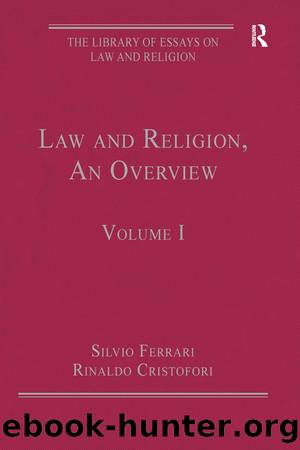Law and Religion, An Overview by Silvio Ferrari

Author:Silvio Ferrari [Ferrari, Silvio]
Language: eng
Format: epub
ISBN: 9781351560764
Barnesnoble:
Publisher: Taylor & Francis
Published: 2017-07-05T00:00:00+00:00
Conclusions
The presented analysis of church-state relations in Orthodoxy reveals that neither the theological concept of symphony nor the Cold War thesis defining them as caesaropapism can offer adequate explanation for their dynamics throughout history. Although symphony exerted a great influence on the development of church-state relations in the Eastern European societies that adopted Christianity from Byzantium, they were not able to absorb its essence deriving from the Byzantine cosmogony but followed mostly its external aspects. In this sense, the archetype of symphony did not outlive Byzantium but remained locked within its historical space and time. The thesis of caesaropapism is much weaker than that of symphony because it tends to convey ideas and notions born in a religious, political, and cultural milieu other than Eastern European Orthodox society. Moreover, it neglects the practices of Orthodox hierarchs to act as state rulers when the corresponding civil authorities are not able to fulfill these duties.
This article also explores the popular thesis of Orthodoxy as a triad of church, state, and nation. It reveals that it is applicable only to those Eastern European states where the majority of the population belongs to this Christian denomination but is not relevant to Orthodox churches that present religious minorities, e.g., the Patriarchate of Alexandria or the Polish Orthodox Church. Therefore, the triad cannot be regarded as an inherited feature of Eastern Orthodoxy but as a modern development provoked by the advent of nationalism. Since the nineteenth century, however, this triad has become an important factor in determining the church-state relationship in states where the majority of population is affiliated with Orthodoxy such as Russia, Greece, and Romania. Moreover, despite their aim to build fully atheist societies, the communist regimes also made use of the close links between the Orthodox churches, their nations, and states. It seems that this experience continues to influence church-state relations in Eastern Europe after the end of the Cold War and thus needs additional research.
The historical overview of church-state relations in Orthodox lands also indicates that local governments and churches have tended to adopt the western principles of freedom of religion and separation of church and state to a lesser or greater degree. Still their application not only takes into account the historical experience of the Orthodox people but is also influenced by the concrete political circumstances in their states, e.g., the adoption of Leninâs formula for the separation of church from state. Being imposed by force after World War II, the principle of separation provokes confusion in Eastern European societies after the fall of communism. Many people find it difficult to distinguish the previous atheist state from the new secular state. As a result, not only do the Orthodox churches claim a restoration of their interwar status as dominant religious institutions in their countries, but also the local governments in the former communist states tend to grant a privileged status to traditional churches at the expense of religious minorities. At the same time, the governments of Orthodox Greece and Cyprus that
Download
This site does not store any files on its server. We only index and link to content provided by other sites. Please contact the content providers to delete copyright contents if any and email us, we'll remove relevant links or contents immediately.
| Antitrust | Civil Law |
| Emigration & Immigration | Federal Jurisdiction |
| Housing & Urban Development | Indigenous Peoples |
| Land Use | Public |
| Public Contract | Public Utilities |
| Urban, State & Local Government |
Machine Learning at Scale with H2O by Gregory Keys | David Whiting(4051)
Killers of the Flower Moon by David Grann(3928)
Oathbringer (The Stormlight Archive, Book 3) by Brandon Sanderson(2819)
Will by Will Smith(2762)
Once Upon a Broken Heart by Stephanie Garber(2640)
Guns, Germs and Steel by Diamond Jared(2263)
Borders by unknow(2187)
It Starts With Us (It Ends with Us #2) by Colleen Hoover(2170)
Friends, Lovers, and the Big Terrible Thing by Matthew Perry(2094)
The Room Where It Happened by John Bolton;(2084)
The Color of Law by Richard Rothstein(1864)
HBR's 10 Must Reads 2022 by Harvard Business Review(1754)
The Strength In Our Scars by Bianca Sparacino(1752)
A Short History of War by Jeremy Black(1739)
Water Rights and the Environment in the United States by John Burch(1634)
Examples & Explanations: Administrative Law by William F. Funk & Richard H. Seamon(1586)
515945210 by Unknown(1579)
A Game of Thrones (The Illustrated Edition) by George R. R. Martin(1550)
Pharmacy Practice and The Law by Richard Abood(1527)
